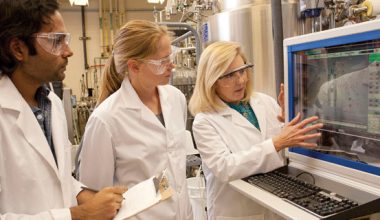Many students obtain a bachelor’s degree by attending a four-year institution immediately after high school. Meanwhile, more are adopting the 2+2 Program, which involves attending a community college for the first two years after high school and transferring to a university or college for another two years.
This approach is cost-effective as it can help you save thousands of dollars. With the hike in living costs and tuition in schools throughout the United States, this is a valuable approach to learning. Furthermore, some students use the 2plus2 system because their grades won’t grant them admission into a four-year college.
So, they take up community college coursework to improve their academic grades and transfer to a four-year university after two years in community college. This guide will teach you everything you need about the 2+2 Program.
Table of contents
What is a 2+2 Program?
A 2+2 program is an educational approach that enables students to finish their first two years of higher education at a community college and transfer to a four-year university to complete their last two years of bachelor’s degree.
Typically, a 2+2 program involves students spending the first two years at a community college where they take foundational coursework and finish their general education requirements. Afterward, students can transfer their credits to a four-year college upon completing their community college education.
You can concentrate on your major coursework and complete your bachelor’s degree at a four-year college. This Program is ideal for saving money since community college tuition is lower than four-year colleges. In addition, 2+2 programs can help students to understand their career objectives and academic interests before starting a four-year program.
Again, it allows students to ease into the college experience, study several academic subjects, and raise their academic status before transferring to a more prominent university. While a 2plus2 program commonly refers to this particular approach, it’s vital to remember that there can be differences and specific agreements between various institutions.
As a result, it is always advised to do your research and speak with the relevant institutions or universities to learn the specifics and prerequisites of their 2plus2 programs.
How Does The 2+2 Program Work?
A 2plus2 program is designed to offer a seamless transition for students from a two-year community college to a four-year university. See how it typically works below:
Admission into a community college
The first step for students is to apply to and get accepted into a community college or a two-year institution that offers the 2plus2 Program. Meanwhile, admission requirements may change depending on the particular college, although they often request a high school diploma or equivalent.
Completion of general education requirements
During their first two years at the community college, students concentrate on finishing the general education requirements, which include English, math, social sciences, natural sciences, and humanities courses. The broad intellectual foundation of general education courses ensures students receive a well-rounded education.
Course planning and advising
Academic advisors are typically available in community colleges to help students choose courses that will satisfy their general education requirements and complement their desired major at the four-year university. Furthermore, advisors assist students in understanding transferable credits, course equivalencies, and program requirements to promote a seamless transition.
Researching and selecting a four-year college
Most students begin investigating potential four-year institutions while at the community college. They consider its programs, location, cost, reputation, and transfer policies. So, understanding which credits will transfer requires carefully reviewing the specific transfer or articulation agreements between the community college and the desired four-year institution.
Application and admission into a four-year college
Students start the transfer application process when they are close to finishing their two-year degree. They fill out the required application forms, provide official community college transcripts, and satisfy any additional specifications required by the four-year university, such as test scores or personal essays. Then, the four-year college or university makes decisions for admissions.
Transfer of credits
The transferability of the student’s community college credits is assessed upon acceptance to the four-year university. The receiving university decides which credits are accepted and how they correspond to the student’s selected major. Lastly, the student’s academic advisor at the four-year college works with the student to develop a plan to complete any outstanding degree requirements.
Completion of bachelor’s degree
After transferring to a four-year college, students concentrate on finishing the final two years of their bachelor’s degree. This includes completing any outstanding general education requirements, major-specific coursework, and additional graduation requirements required by the four-year university.
Students can follow this procedure to earn their associate degree at the community college and then transfer readily to a four-year institution to complete their bachelor’s degree. To ensure a successful transfer, students must consult with academic advisers at the community college and the four-year university. Meanwhile, the Program’s specifics may vary based on the precise agreements between institutions.
Check out: What AP Classes Should I Take? Guide To Pick The Right AP Classes.
Pros of The 2+2 College Program
There are many reasons to consider a 2plus2 program. Its benefits include the following:
1. It is cost-effective.
Unlike traditional four-year colleges, community colleges offer low tuition fees, making the 2+2 Program an economical and excellent option for students. Additionally, the first phase of many 2plus2 programs ends with a certification related to your chosen degree. You can work in your profession and obtain practical experience during the second half of your studies. It saves you money too.
2. It’s flexible.
Due to their flexibility, community institutions are also excellent for non-traditional and traditional students who desire to work. Also, community colleges usually offer evening and weekend sessions in addition to summer, short-term, and online courses for students with hectic schedules. Furthermore, students can explore various career paths and majors before committing to a four-year degree. Thus, they can make more informed decisions about their education and future.
3. More support.
Community colleges are often smaller than universities and frequently provide more specialized help for students who recently graduated from high school or have taken a break from academics. Classes are often small, giving students plenty of chances to interact with their classmates and teachers.
Again, community colleges are excellent for international students to take programs to improve their English-language reading and writing. They can also assist you in improving your academic standing or helping you acquire scholarships or financing for further study.
4. They cater to minority, non-traditional, and first-generation students.
Community colleges appeal to international students, non-traditional students, and people who need more financial means to attend four-year universities. They are supportive, affordable, and accessible. Additionally, students who complete the first phase of a 2+2 program are on a fast track to four-year degrees and university entrance.
5. They’re easily accessible.
Community colleges are more accessible than universities but can also be more accessible to students because of their less stringent entrance requirements. Meanwhile, community colleges are typically regional and located in smaller cities or communities, contributing to their potential for being less expensive than universities.
Cons of The 2+2 College Program
Although the 2+2 college program has several benefits, as discussed above, it still has drawbacks. So, below are the most common drawbacks of this Program:
- While enrolling in a community college. The first two years may result in lower tuition costs, and you will pay more for housing and transportation. In addition, taking remedial classes at the community college can raise your overall fees.
- If your preferred four-year university doesn’t admit you, you might need to transfer to another school. Your academic progress may be hampered, and meeting new people may be more challenging.
- Again, you might need to take more courses or repeat some of the subjects you already did because all credits from community colleges do not transfer to four-year institutions. As a result, your education may take longer and cost more.
- Unlike four-year institutions, community colleges typically have smaller student populations, which might make it more challenging to build friends and connections. Time for extracurricular activities may also be limited because many community college students work or have other commitments.
- Community colleges often offer fewer extracurricular activities. This may be a problem if you want a well-rounded college experience.
- Four-year institutions may offer more access to research opportunities, internships, and practical experiences than community colleges. There may be fewer opportunities for these early experiential learning opportunities for students who begin at a community college.
- Community colleges offer fewer courses, particularly in specialized or specialty subject areas. This may restrict students’ options and impede their ability to advance in their chosen major. Before enrolling in a 2+2 program, students should thoroughly investigate the availability and transferability of courses.
See also: Things I Wish I Knew Before College | 30 Untapped Advice in 2024
How To Apply For a 2+2 College Program
Below are the general steps to follow when considering applying for a 2+2 college program:
- Do your research.
Start by researching four-year institutions with established transfer agreements and community colleges that offer 2+2 programs. Program offers, reputation, location, pricing, and transfer policies are a few things to consider. Review each Program’s requirements and unique benefits.
- Contact the community college and four-year university.
Contact the community college and the four-year institution immediately after discovering a program you are interested in to learn more about the application procedure. Understanding the requirements before applying is crucial because each Program will have different needs.
- Meet the admission prerequisites.
Learn about the prerequisites for admission to the four-year university and the community college. Community colleges typically have open admission policies, but four-year universities could have more stringent conditions. So, ensure you meet the qualifications for both institutions, including a high school diploma or equivalent, standardized test scores, and any other requirements.
- Apply to the community college.
Complete the 2+2 program application process at the community college. This often entails completing an application form, supplying certified high school or prior education transcripts, and paying application fees. Again, observe application deadlines and specifications, like prerequisite courses or placement tests.
- Research transfer requirements.
After finishing the community college component, research the precise transfer criteria for the four-year university you wish to transfer to. Find transfer advisors, articulation agreements, or guidelines that can advise you on the required coursework, GPA standards, and other transfer requirements. Afterward, recognize the credit transfer policies and the courses that will be accepted toward your selected major.
- Plan your coursework.
Interact closely with academic counselors at the community college to properly organize your education. Ensure you meet the four-year institution’s general education requirements and any prerequisites for your desired major. Monitor your progress and speak with advisors frequently to ensure you are on pace to fulfill the transfer requirements.
- Prepare for transfer.
Start preparing for the transfer procedure as your two years at the community college end. Then, learn about the four-year institution’s admission standards and application process. Obtain the relevant paperwork required by the institution, including official transcripts, letters of recommendation, and personal statements.
- Apply to a four-year university.
Complete the four-year institution’s application process. Send in the application form, the community college’s official transcripts, the test results (if necessary), and any other documentation that has been requested. Then, stay updated about the application deadlines and submit the required paperwork on time.
- Communicate with transfer advisors.
Contact the transfer advisors at the community college and the four-year university frequently. They can assist you with any queries or worries, walk you through the transfer procedure, and give you information on credit transferability.
About Harvard 2+2 Program
Harvard 2+2 program is a medium for students in college or full-time master’s degree programs to apply to Harvard Business School on a deferred basis. The Program consists of at least two years of professional work experience and two years in the regular Harvard Business School MBA program.
If you’re an innovative thinker with analytical and leadership skills and want to build your passion and knowledge to stand out, you’re an ideal candidate for the HBS 2+2 program. After your acceptance through 2+2, you will spend at least two years (and at most four years) working in a professional role in a non-profit, private, or public sector before enrolling at HBS.
Check out: What Is Non-Traditional High School? Fully Explained
Eligibility For The HBS 2+2 Program
Below are the requirements you must fulfill to apply for the HBS 2+2 program:
- You can apply for the bachelor’s degree program if you’re an undergraduate in your final study year.
- Individuals in joint Bachelor/Master’s Degree programs can apply.
- Applicants from master’s degree programs who haven’t worked full-time (apart from internships or co-op) can apply. Candidates must have gone directly from undergraduate to graduate school to apply for the Harvard 2+2 program.
- The Harvard 2+2 program is not open to students enrolled in Ph.D. programs, law school, or medical school; instead, these students should apply using the usual admissions process.
Here’s more information about the application process and steps for the Harvard 2+2 program.
Frequently Asked Questions
The Associate of Arts or Science (AA/AS) degree is earned in the first two years of study at a community college under the 2+2 degree program, which allows students to transfer (plus two years) to a four-year college to complete their bachelor’s degree.
The average GPA for Harvard 2+2 Program is 3.79
The primary benefit of the Harvard 2+2 program is that it guarantees you deferred enrollment at Harvard as long as you work for a minimum of two years after your admission.
Approximately 8–10% of Harvard’s 2+2 program applicants are accepted.
Conclusion
Saving money and improving your chances of admission to a top-tier college or university are both possible with 2+2 programs. Through these programs, you can get your associate’s degree at a community college and transfer to a four-year institution with junior standing. So, you can choose a 2plus2 program that is ideal for you from among the numerous offered.
References
- bachelorstudies.com – Why a 2+2 Program Could Be Right For You
- hbs.edu – 2+2 Program
- bestaccreditedcolleges.org – Is a 2 + 2 Program Right for You?



